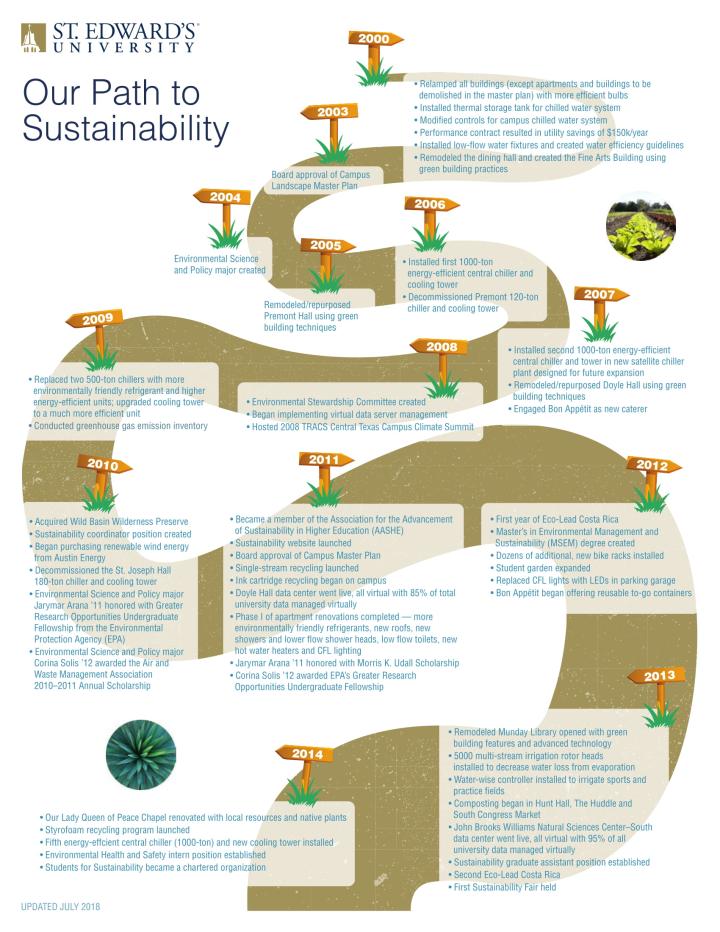Maintaining Our Beautiful Campus
From the ground we walk on to the air we breathe, St. Edward's University works tirelessly to maintain the campus environment. See how below.

Sustainability Timeline
The sustainability timeline chronicles the progress that St. Edward's has made towards sustainability in the past 19 years. View a PDF version of the sustainability timeline.
Campus Operations
In 2003, the Board of Trustees approved the 2003 Campus Landscape Master Plan to provide the university with guidance for planting more trees to help clean the air and prevent soil erosion, planting more native plants to conserve water, creating a more pedestrian campus to reduce vehicle traffic on campus, and creating a more inviting campus so that students, faculty, and staff can enjoy the outdoors as meeting and recreational spaces.
In May 2011, the Board of Trustees approved the 2011 Campus Master Plan that provides the St. Edward's campus with building sustainability guidelines to ensure that building performance is consistent with campus-wide sustainability goals.
In 2017, the Board of Trustees approved the 2018 Campus Master Plan to integrate stewardship of the natural and built environment into the future of the University. The 2018 Campus Master Plan seeks to reflect the University's mission and values while keeping with the strategic plan.
Maintenance
Facilities uses an online work order system, allowing faculty and staff to efficiently notify Facilities of maintenance issues. This enables maintenance staff to address issues quickly, thereby decreasing waste. Student needs are addressed through both Student Life and Residence Life offices. Facilities conducts preventive maintenance at varying intervals to inspect plumbing, chilled water and electrical systems. The reporting and tracking features of the system allows Facilities to monitor and analyze maintenance issues throughout campus and quickly find and correct ongoing problems.
Housekeeping
Housekeeping plays a major role in collecting recycled materials from buildings across campus. They also assist in composting by ensuring that the contents of the green plastic bags in the bathrooms are disposed of properly.
Groundskeeping
A signature of our campus, the beautiful grounds and landscape play a large role in our effort to be environmentally conscientious. Since 1999, Facilities has planted native plants and over 900 trees to conserve water and provide natural shading. In addition, Facilities has installed four water meters that provide water to our irrigation system; water-wise controllers are tied to on-site weather stations, and are using micro-irrigation for all landscape beds and trees. All grass clippings are mulched and returned directly to the ground. Tree branches and fall leaves are chipped on site and composted for later use in the landscaping.
In recognition of our dedication to our campus trees, we have been recognized as a Tree Campus USA for five consecutive years; 2015-2019.
Greenhouse Gas Inventory
The Greenhouse Gas Inventory tracks the total annual greenhouse gas emissions at St. Edward's University, providing Hilltoppers with a better understanding of the sources and trends in the university's Greenhouse Gas emissions (GHG) in an effort to improve current sustainability practices.
This inventory began in 2009 as an undergraduate research project and continues today.
- 2018-2019 GHG Summary
- 2015-2016 GHG Summary
- 2014-2015 GHG Summary
- 2013–2014 GHG Summary*
- 2012–2013 GHG Summary
- 2015 MSEM Final Paper: Comparison of Carbon Sequestration Methodologies for Use by Academic Institutions in Texas by Suzzanne Gamboa, Erica Joelson, and Christina Mcglew, MSEM Cohort 3
*The offsets from Wild Basin have been updated to carbon storage per year, whereas previous reports are in the total value of carbon storage with no time stamp. This is a more accurate measure of offsets, but does cause the net emissions to be much higher than previous reports.

Media Features
Sustainability happenings have been featured in several on and off-campus publications. Check out some highlights.
Environmental Management System
The Environmental Management System (EMS) encourages the university to realize its environmental goals and continuously improve its environmental performance through consistent controls of its operations. The EMS operates in a repeating cycle, beginning with a policy statement that is turned into a plan that is implemented, evaluated and revised. The cycle repeats, and continuous improvement occurs. Learn more about the St. Edward's EMS.
Sustainability Committee
The St. Edward's University Sustainability Committee's purpose is to integrate new and existing efforts to maximize success and awareness, support sustainability-related policy development when needed, and to increase community outreach by informing community members to increase awareness and work with students groups to promote messages and commitment to the university.
The Sustainability Committee is represented by the following groups:
- Admission Office
- Facilities
- Faculty
- Information Technology
- President’s Office
- Campus Ministry
- Student Affairs: Housing, and RecWell (wellbeing)
- Students for Sustainability (Student Organization)
- Student Government Association
- Students
- Wild Basin Creative Research Center
